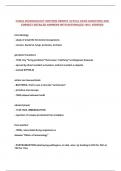TCDHA MICROBIOLOGY MIDTERM NEWEST ACTUAL EXAM QUESTIONS AND
CORRECT DETAILED ANSWERS WITH RATIONALES 100% VERIFIED
microbiology
- study of small life forms/microorganisms
- viruses, bacteria, fungi, protozoa, archaea
girolamo fracastoro
- 1546, tiny "living particles" that cause "catching" (contagious) diseases
- spread by direct contact w humans, indirect contact w objects
- named SYPHILIS
antoni van leeuwenhoek
- BACTERIA, first to see a microbe "animicules"
- primitive microscope
- 1683 plaque between teeth
edward jenner
- 1749-1823, IMMUNIZATION
- injection of cowpox protected from smallpox
louis pasteur
- 1859s, associated living organisms w
disease "father of immunology"
- PASTEURIZATION (destroying pathogens, in milk, wine. by heating to 63C for 30m or
72C for 15s)
,- first VACCINES for rabies, cholera, anthrax
john tyndall
- 1820-1893, TYNDALLIZATION (PROLONGED heating to destroy bacteria)
- bacteria exist in 2 forms (heat sensitive/heat stable-wont be always b killed by heat)
ferdinand cohn
- 1828-1898, ENDOSPORES (dormant form of bacteria w enhanced resistance to heat,
staining & disinfection)
joseph lister
- 1827-1912, airborne MOs can be reduced w carbolic acid (PHENOLS)
- used in WW11 surgeries to clean wounds
- used to boil instruments, wash hands and surgical linens
christian gram
- 1853-1938 GRAM STAINING (2 dyes- violet and red)
- divides bacteria - gram pos or neg
- determines the difference in cell wall
,ignaz phillip semmelweis
- 1861, published "the cause, concept and prophylaxis of childbed fever" - how
HANDWASHING by doctors would save lives
sir alexander fleming
- 1928, worked on flu & observed MOLD developed on staphylococcus culture plate and
created a bacteria-free circle
- PENICILLIN
robert koch
- causative agents of TUBERCULOSIS, CHOLERA, ANTHRAX
- (mycobacterium tuberculosis, koch's postulates, anthrax bacterium, asiatic cholera)
probiotics
microbes that can confer a health benefit in adequate amounts (sauerkraut, dairy, miso
soup, sourdough bread.)
, bacteria
- vary in size, shape & arrangement of cells
- grows best at 98.6F in moist, dark
good or bad
aviruses
- small (100x smaller than bacteria)
- can cause FATAL diseases
- MO can live and multiply ONLY inside an appropriate host cell (parasites)
algae
- range from SINGLE celled to LARGER MULTIPLE cell organisms
- seaweed and kelp, most don't produce disease
protozoa
- large group of ONE CELLED organisms; don't have a rigid cell wall
- in freshwater, marine habitat and moist soil
small # responsible for intestinal infections and others invade blood, lungs, liver, brain
4 types
- amoeba, ciliates, sporozo, and flagellates
fungi
- mushrooms, yeast, mold
- oral candidiasis




